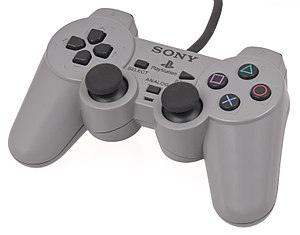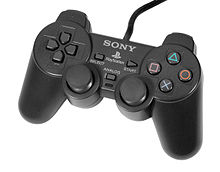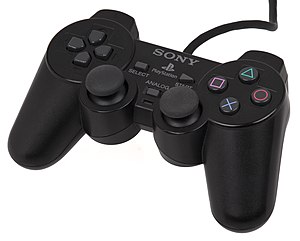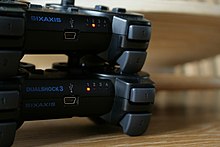DualShock: Difference between revisions
→DualShock 4: free image replacement |
JoeJohnson2 (talk | contribs) →DualShock 4: ud |
||
| Line 130: | Line 130: | ||
{{Infobox information appliance |
{{Infobox information appliance |
||
|title=DualShock 4 |
|title=DualShock 4 |
||
|image=[[File: |
|image=[[File:Playstation 4 Controller.png|300px]] |
||
|caption= |
|caption= |
||
|manufacturer=[[Sony Computer Entertainment]] |
|manufacturer=[[Sony Computer Entertainment]] |
||
Revision as of 15:17, 15 June 2013
The DualShock (trademarked as DUAL SHOCK[1]) is a line of vibration-feedback gamepads by Sony for the PlayStation, PlayStation 2, PlayStation 3 and PlayStation 4[2] video game consoles. The DualShock was introduced in Japan in late 1997, and launched in the North American market in May 1998. First introduced as a secondary peripheral for the original PlayStation, a revised PlayStation version came with the controller and Sony subsequently phased out the digital controller that was originally included with the console, as well as the Sony Dual Analog Controller. As of June 2008, over 28 million controllers have been sold in the DualShock line[3] (excluding bundled controllers).
Original DualShock
 Original grey version of the DualShock controller | |
| Manufacturer | Sony Computer Entertainment |
|---|---|
| Type | Video game controller |
| Generation | Fifth generation era |
| Lifespan | November 20, 1997[4] |
| Discontinued | December 31, 2004 |
| Input |
|
| Connectivity | PlayStation (2) controller port |
| Dimensions | Body
Cable
|
| Predecessor | Dual Analog |
| Successor | DualShock 2 |


The DualShock Analog Controller (SCPH-1200) is a controller capable of providing vibration feedback based on the on-screen action of the game (if the game supports it), as well as analog input through two analog sticks. The controller's name derives from its use of two (dual) vibration motors (shock). These motors are housed within the handles of the controller, with the left one being larger and more powerful than the one on the right, so as to allow for varying levels of vibration. The DualShock differs from the Nintendo 64's Rumble Pak in this respect as the Rumble Pak only uses a single motor. The Rumble Pak also uses batteries to power the vibration function while all corded varieties of the DualShock use power supplied by the PlayStation. (However, some third party DualShock-compatible controllers use batteries instead of the PlayStation's power supply.) The rumble feature of the DualShock is similar to the one featured on the first edition of the Japanese Dual Analog Controller, a feature that was removed shortly after that controller was released.
Like its predecessor, the Dual Analog, the DualShock has two analog sticks. However, unlike its predecessor, the DualShock's analog sticks feature textured rubber grips instead of the smooth plastic tips with recessed grooves found on the Dual Analog controller's analog sticks. The DualShock also features two additional buttons when compared to the Dual Analog, L3 and R3, which are triggered by pressing the analog sticks down. Other differences between Dual Analog and the DualShock include the longer grips/handles and slightly different L2/R2 buttons found on the Dual Analog.
The controller was hugely supported; shortly after its launch most new titles, including Crash Bandicoot: Warped, Spyro the Dragon, and Tekken 3 included support for the vibration feature and dual analog sticks. Some games designed for the Dual Analog's vibration capability, such as Porsche Challenge and Crash Bandicoot 2, also work. Many games took advantage of the presence of two motors to provide vibration effects in stereo including Gran Turismo and the PlayStation port of Quake II. Released in 1999, the PlayStation hit Ape Escape became the first game to explicitly require DualShock/Dual-Analog-type controllers, with its gameplay requiring the use of both analog sticks.
The DualShock is also compatible with the PlayStation 2, as they use the same connector and protocol. However, certain PS2 games that utilize the DualShock 2's analog buttons, such as The Bouncer, are not compatible with the DualShock. The DualShock is fully forwards compatible with the PlayStation 2 when that console is used to play PlayStation games.
DualShock 2
 DualShock 2 controller | |
| Manufacturer | Sony Computer Entertainment |
|---|---|
| Type | Video game controller |
| Generation | Sixth generation era |
| Discontinued | January 4, 2013[citation needed] |
| Input |
|
| Connectivity | PlayStation (2) controller port |
| Dimensions | Body
Cable
|
| Predecessor | DualShock |
| Successor | Sixaxis, DualShock 3 |
When the PlayStation 2 computer entertainment system was announced, the DualShock 2 Analog Controller (SCPH-10010) included with it was almost exactly the same externally as the previous DualShock analog controller, except that it was black (other colors came later), had different screw positioning in the back which counted one fewer screws, and the DualShock 2 logo was added. Another way to tell the DualShock and the DualShock 2 controllers apart is that the connector that plugs into the console matches that console's memory card shape; the DualShock’s connector has rounded shoulders and DualShock 2's is squared off. The analog sticks were also noticeably stiffer for more accurate movements.
Internally, the DualShock 2 was lighter and all of the buttons (except for the Analog mode, start, select, L3 and R3 buttons) were readable as analog values (pressure sensitive).[5]
The DualShock 2 has been made available in various colors such as: black, satin silver, pink, white, transparent grey, blue, green, and red.
The DualShock 2 is also backwards compatible with the original PlayStation, and is forwards compatible with the PlayStation 3 through the use of third party peripherals designed to create a connection between the wire of the controller and the console's USB ports. However, the DualShock 2 will not work properly with games that require the Sixaxis functions, such as Heavy Rain.
DualShock 3
 DualShock 3 controller | |
| Manufacturer | Sony Computer Entertainment |
|---|---|
| Type | Video game controller |
| Generation | Seventh generation era |
| Lifespan | |
| Input |
|
| Connectivity | USB, Bluetooth (PS3 and PSP Go) |
| Power | Lithium-ion battery (3.7 V 300 mA or 5.0 V[citation needed] 500 mA[citation needed]), USB host powered |
| Dimensions | 160 mm × 97 mm × 55 mm 6.20 in × 3.78 in × 2.20 in |
| Mass | 192 g 6.77 oz |
| Predecessor | Sixaxis, DualShock 2 |
| Successor | DualShock 4 |


Announced at the 2007 Tokyo Game Show, the DualShock 3 wireless controller (SCPH-98050/CECHZC2) is a gamepad for the PlayStation 3. It replaces the Sixaxis wireless controller originally released with earlier versions of the console. The DualShock 3 is nearly identical to the previous Sixaxis version but adds the haptic feedback – also known as force feedback – capabilities found in the DualShock and DualShock 2. Sony settled a patent infringement lawsuit with Immersion in March 2007 following a lengthy legal battle. The settlement cleared the way for incorporating the missing "rumble" feature that the Sixaxis lacked.[8] Both the vibration function and motion-sensing capabilities of the DualShock 3 can be used simultaneously without one interfering with the other. Like the Sixaxis, it also has a USB mini-B port for charging and can also be used on a PSP Go via Bluetooth, though the controller and the PSP Go must be registered using a PS3 console.
The DualShock 3 can be identified by its "DualShock 3" and "Sixaxis" markings. It also weighs 192 grams (6.8 oz), 40% more than its predecessor, the Sixaxis, which weighed only 137.1 grams (4.84 oz). Additionally, the DualShock 3 is made from opaque plastic rather than the Sixaxis's slightly translucent plastic.[citation needed]
The rear markings indicate the original DualShock 3 draws up to 300 mA of current at 3.7 V for a power consumption of 1.11 W, an order of magnitude increase from the 30 mA of current at 3.7 V (0.111 W) listed on the Sixaxis. However, this current is not drawn constantly and is the maximum current when the rumble is active. Its main power source is an internal 3.7 V Li-ion battery, which provides up to 30 hours of continuous gaming on a full charge. Third party replacement batteries are also available. Like the Sixaxis, the DualShock 3 comes with instructions on how to remove and replace the battery. The DualShock 3 can also draw power over a USB cable via a USB mini-B connector on the top of the controller. This allows the controller to be used when the battery is low and is also used for charging the battery. When connected via USB, the controller communicates with the console through the USB cable, rather than Bluetooth.
Along with the release of the 'slim' model PS3, Sony released a new version of the DualShock 3 (A1) which uses 5.0 V at 500 mA while connected, but still contains a 3.7 V battery.[citation needed] This revision of the DualShock 3 does away with the additional plastic brackets between the L1/R1 buttons and the L2/R2 triggers (increasing controller rigidity), has indicator lights soldered directly to the board (causing the light emitted to bleed through to the front of the controller), and comes in slightly revised color schemes.[citation needed]
While the DualShock 3 is compatible with any standard USB mini-B cable and many USB chargers, official charging cables are available from Sony. These include an official cable, the USB 2.0 Cable Pack and a wall charger, the AC adapter charging kit. Any third-party USB charger used must act as a USB host device, rather than simply providing power over the appropriate pins, since both the Sixaxis and DualShock 3 require a host signal to "wake up" and begin charging.
A Sony representative confirmed on April 2, 2008 that the original Sixaxis controller would officially be discontinued with the release of the force-feedback enabled DualShock 3 in mid-April 2008. The Sixaxis is no longer being produced and is no longer in stock in most stores.[9]
Available colors and variations
The DualShock 3 has been made available in various colors: black, satin silver, ceramic white, classic white,[10] metallic blue,[11] deep red,[11] pink,[12] "jungle green",[13] "candy blue" (light blue),[14] "urban camouflage" (three-color digital camouflage)[15] and "cosmic blue" (transparent blue).[16] Not all colors have been made available in all markets or at all times.
Additional colors have also been made available alongside limited edition consoles, including gun-metal grey[17] and "cloud black" (dark grey).[18]
A limited edition baseball themed DualShock 3 controller was released on March 8, 2011 to coincide with the release of MLB 11: The Show.[19] Another color, "Metallic Gold", became available in June 2012 as a limited edition in Europe,[20] while in North America it is sold exclusively in GameStop from October 2012.[21][22] A limited edition God of War: Ascension controller is available in the UK as part of a console bundle to coincide with the launch of the game[23] and in the Americas as a game and controller bundle.
DualShock 4
 | |
| Manufacturer | Sony Computer Entertainment |
|---|---|
| Type | Video game controller |
| Generation | Eighth generation era |
| Lifespan | Q4 2013 |
| Input |
|
| Connectivity | microUSB 3.0, Bluetooth v2.1+EDR[25] |
| Power | 3.7 V 1000 mAh Li-ion battery,[25] USB 3.0 host powered |
| Dimensions | 162 mm × 52 mm × 98 mm[25] 6.4 in × 2.0 in × 3.9 in |
| Mass | 210 g[25] 7.4 oz |
| Predecessor | DualShock 3 |
The DualShock 4 will be the PlayStation 4's controller. It is similar to the DualShock 3, with several new features. One new feature is a built-in two-point capacitative touch pad on the front of the controller, which can be clicked.[25] The controller will support motion detection via a three-axis gyroscope and three-axis accelerometer and vibration.[25] It will include a non-removable,[26] rechargeable 3.7 V lithium-ion battery tentatively capable of storing 1000 mAh.[25] The tentative design weighs 210 g (7.4 oz) and has dimensions of Template:Convert/3.[26]

There is a light bar that can display different colors, used to indicate which player is which and to indicate critical messages such as low battery level.[25] This is used to communicate with a dual camera attachment; the external camera attachment perceives movement and depth by using the controller's light bar.[citation needed]
The controller features several output connectors: a stereo headset jack (3.5 mm TRS connector), a micro USB port and an extension port.[25] It can be charged via microUSB, a dedicated charging station, or the console (even when the console is off).[25] It will also include a mono speaker.[25]
The DualShock 4 features the following buttons: PS button, SHARE button, OPTIONS button, directional buttons, action buttons (triangle, circle, cross, square), shoulder buttons (R1/L1), triggers (R2/L2), analog stick click buttons (L3/R3) and a touch pad click button.[25] These mark several changes from the DualShock 3 and other previous PlayStation controllers. The START and SELECT buttons have been merged into a single OPTIONS button.[25][26] A dedicated SHARE button will allow players to upload video from their gameplay experiences.[25] The joysticks and triggers have been redesigned based on developer input.[25] with the rigged surface of the joysticks now featuring an outer ring surrounding the concave dome caps.
Emmy Award
The DualShock controller was given an Emmy Award for "Peripheral Development and Technological Impact of Video Game Controllers" by The National Academy of Television Arts & Sciences on January 8, 2007.[27] Sony initially reported that the Sixaxis had received this award[28] before issuing a correction.[29]
References
- ^ "第4280605号". 商標出願・登録情報. Industrial Property Digital Library (via WebCite). June 4, 1999. Retrieved August 14, 2010.
- ^ Morell, Chris (20 March 2008). "DualShock 3 for PS3". GamePro. Archived from the original on 2008-03-24. Retrieved 2008-08-21.
- ^ a b c "DualShock 3 Wireless Controller available for PlayStation 3 this summer". Next-Gen.biz. 2008-07-01. Retrieved 2008-07-01.
- ^ "SCPH". maru-chang.org.
- ^ "Dual Shock 2 Review". IGN. 2001-09-27. Retrieved 2008-12-07.
The biggest difference between the Dual Shock 2 and the original ... is the fact that ... all of the buttons and even the digital pad offer analog support. This means that the d-pad, the four face buttons and the four shift buttons are all pressure sensitive and have 255 degrees of sensitivity. ... It's also worth noting that the Dual Shock 2 is a bit lighter than the original Dual Shock.
- ^ a b Yam, Marcus (April 3, 2008). "SIXAXIS PS3 Controller Discontinued; DualShock 3 is Here". DailyTech. Retrieved April 8, 2013.
- ^ "DUALSHOCK3 Wireless Controller available for PLAYSTATION3 this summer". Sony Computer Entertainment Europe. 2008-06-30. Retrieved 2008-06-30.
- ^ Cohen, Peter (February 26, 2008). "PS3 DualShock 3 controller coming in April". Macworld. Retrieved April 8, 2013.
- ^ MTV Multiplayer » Sony Non-Shocker: Sixaxis Discontinued
- ^ Hollister, Sean (September 5, 2010). "'Classic White' DualShock 3 appears at e-tail, dreaming of an alabaster console". Engadget. Retrieved September 10, 2010.
- ^ a b Miller, Paul (July 28, 2009). "Sony's red and blue DualShock 3 controllers land in October, love this country". Engadget. Retrieved September 10, 2010.
- ^ McElroy, Griffin (September 10, 2010). "Pink DualShock 3 controller coming September 21". Joystiq. Retrieved September 10, 2010.
- ^ "Amazon.com: DualShock 3 Controller - Jungle Green: Video Games". amazon.com. Retrieved December 26, 2010.
- ^ "Japan: New PS3 controller colour, peripherals announced". CVG. March 1, 2011. Retrieved March 1, 2011.
- ^ "DUALSHOCK®3 – Urban Camouflage - PlayStation®3 Accessories". Sony. Retrieved September 13, 2011.
- ^ "'Sonic Blue' DualShock 3 at Wal-Mart".
- ^ "Gunmetal Grey PS3 Coming to North America". Shacknews. April 10, 2008. Retrieved September 10, 2010.
- ^ North, Dale (January 19, 2009). "Final Fantasy VII Advent Children PS3 bundle is real". Destructoid. Retrieved September 10, 2010.
- ^ "Amazon.com: PS3 DualShock 3 Wireless Controller - MLB 11 The Show Edition: Video Games". amazon.com. Retrieved December 26, 2010.
- ^ "On Your Marks, Get Set, Go…! – PlayStation.Blog.Europe". PlayStation.Blog.Europe. June 5, 2009. Retrieved July 20, 2012.
- ^ [GameStop http://www.gamestop.com/ps3/accessories/dualshock-3-wireless-controller-metallic-gold-gamestop-exculsive/102832 "DUALSHOCK 3 wireless controller - Metallic Gold - GameStop Exclusive"].
{{cite web}}: Check|url=value (help) - ^ Fletcher, JC (June 15, 2012). "PS3 controller goes 'metallic gold' at GameStop". Joystiq. Retrieved July 20, 2012.
- ^ "God of War: Ascension white PS3 bundle unveiled for UK". Joystiq. AOL. 2012-02-06. Retrieved 2013-02-08.
- ^ Sony Computer Entertainment. "Press Release from Sony". Retrieved 21 February 2013.
- ^ a b c d e f g h i j k l m n o (c)Sony Computer Entertainment Inc. "NEW SLIMMER AND LIGHTER PLAYSTATION®3 TO HIT WORLDWIDE MARKET THIS SEPTEMBER | PRESS RELEASES | Sony Computer Entertainment Inc". Scei.co.jp. Retrieved 2013-02-21.
- ^ a b c McWhertor, Michael (2013-01-31). "PS4 touch-sensitive DualShock 4 controller revealed (update: features, scale detailed)". Polygon. Retrieved 2013-02-21.
- ^ "National Television Academy Announces Emmy Winning Achievements: Honors Bestowed at 58th Annual Technology & Engineering Emmy Awards". 2007-09-20. Retrieved 2008-01-11.
- ^ "Sony Computer Entertainment America Wins Emmy Award for PLAYSTATION3 SIXAXIS Wireless Controller". Sony Computer Entertainment America. 2007-01-08. Archived from the original on 2007-01-10. Retrieved 2008-01-11.
- ^ Thorsen, Tor (2007-01-10). "Sony retracts Sixaxis Emmy claims". GameSpot. CNET. Retrieved 2008-01-11.
External links
- Official North American DualShock 3 page
- Official European DualShock 3 page
- Official European PlayStation 4 site, which includes details of the DualShock 4
- Official North American PlayStation 4 site, which includes details of the DualShock 4
